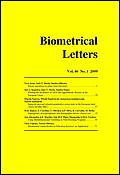
Biometrical Letters vol. 46(1), 2009, pp. 27-41


|
SAPWOOD AREA AND SELECTED QUANTITATIVE CROWN TRAITS IN THE EUROPEAN LARCH (LARIX DECIDUA MILL.)
M. Nawrot1, W. Pazdrowski1, K. Kaźmierczak2, M. Szymański1 1Department of Forest Utilization, Poznan University of Life Sciences, Poland 2Department of Forest Management, Institute of Dendrometry and Forest Productivity Science, Poznan University of Life Sciences, Wojska Polskiego 71c, 60-625 Poznań, Poland, e-mail: kasiakdendro@wp.pl |

The study was an attempt to determine sapwood ring area and to identify relationships between selected quantitative characteristics of the crown and sapwood area. The sapwood ring area measured at breast height is correlated most strongly with crown projection area, followed by crown volume, with the correlation with outer crown area being weakest. Sapwood area measured at crown base is correlated more strongly with biometric crown characteristics. Also the coefficient Pw, being the ratio of outer crown area to sapwood ring area, was calculated for two measurement heights: 1.3 m and crown base. This coefficient assumes higher values for measurements taken at crown base than at 1.3 m. Among trees of the main stand according to Kraft's classification, the coefficient Pw took higher values for trees occupying inferior social classes of tree position in the stand.

sapwood ring area, social class of tree position, crown projection area, crown volume, outer crown area
